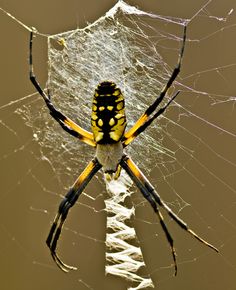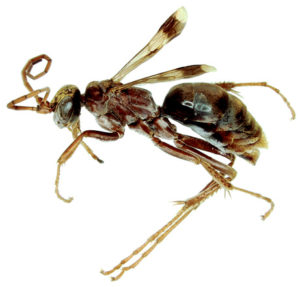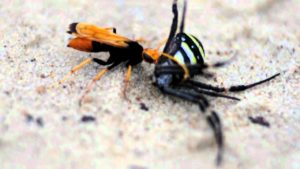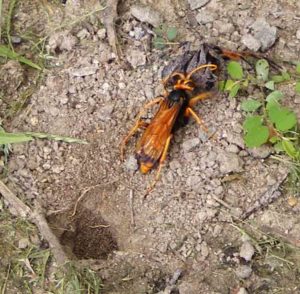There is in this world unspeakable cruelty and barbarism, usually practiced by and attributed to the weaknesses and flaws of humanity. But in nature, unlike in the affairs of men, savagery is driven by instinct. Some species, it seems, are particularly ruthless and even challenge mankind in their cold-bloodedness. I never expected, however, for this to play out at such a miniature level. Warning: what I am about to describe may be too graphic for young children.
Recently, a huge Black & Gold Garden Spider took up residence outside our back porch between the eaves of the roof and the screens which wave lazily in the breeze. Her web included that telltale dense zig-zag of silk in the center. With extra-long forelegs and backward-sweeping hind legs, this arachnid’s reach would’ve easily spanned a small child’s hand. Despite being initially creeped out, after several days we became comfortable with one another—home owner and squatter. I named her Blanche. I even introduced Blanche to our grand kids: “Whoa! . . . that’s SO awesome, grandpa!” Over the next several days Blanche attained celebrity status, enduring numerous annoying smart phone photo shoots from my wife, Kathleen. It was more notoriety than she could take.

Black-and-Yellow Argiope commonly called ‘garden spider’ and web, Virginia 2011
Suddenly one day, she was gone—driven away by the paparazzi effect—to our front porch where she set up her silky trap in a new target-rich hunting ground. Each day I walked within inches of Blanche’s web on my way to the truck and I routinely stopped to check in on my new friend. I was flattered by the unexpected opportunity to observe one of nature’s best hunters ply her trade.
Then one morning, a brazen act of violence was committed in front of me—in broad daylight! I was witness to a kidnapping. At first I thought Blanche had caught lunch . . . then I realized the gruesome irony of what was happening in front of my eyes. On Blanche’s back, well out of reach of her flailing legs, was a blue/black ninja wasp with an orange ring around its abdomen.
The wasp moved with the practiced efficiency of an assassin, stinging Blanche multiple times. Almost instantly, this large and imposing spider—my friend Blanche—was dangling upside down from her own web in a paralyzed stupor. My Blanche, the consummate hunter, had been taken down in her own web! It was a professional hit, as clean as it was noiseless, over in seconds. When later I next passed the crime scene, both Blanche and the wasp were gone. Just an empty, ravaged homestead, the web tattered and windblown in the aftermath of the attack. Is my dog safe? Would I be next? What was this nasty wasp?
And what happened to Blanche? Did she fall into the bushes where I could no longer find her? As I rushed to the Internet to identify the wasp, I was aghast at what I discovered. This was a spider wasp attack! According to the web page, Blanche had most likely been carried off, barely breathing but still alive, to be taken into the dark recesses of the wasp’s burrow and eaten alive by its larva, which would soon hatch from the spider’s body. This could not be. It’s like out of some B-grade horror movie. Hauled off, just like that, to some vampire mausoleum. This is not merely evil . . . this is sin!
After searching through voluminous mug shots of spider wasps, I was unable to spot my individual assailant. I subsequently learned that “spider wasp” is a common name for a number of families of wasp whose young feed on spiders. Wasps in the family Pompilidae are commonly called spider wasps or pompilid wasps. Spider wasps are found pretty much throughout the world. There are about 290 species in the United States and Canada and around 4200 worldwide. They’re all around us! Who knew?
 The spider wasp’s brutality does not stop with merely stinging spiders. Often the spider is too large for the wasp to carry in flight and so the wasp must drag it to the nest. Some species bite off the spider’s legs to make it easier to drag and may drink blood that leaks from the wounds. I’m like. . .seriously??? A real, live body snatcher! This is a wasp that even Hannibal Lector could love. If you care to watch, you can see how it happens here: https://www.youtube.com/watch?v=rs_Q7S3Rxkk.
The spider wasp’s brutality does not stop with merely stinging spiders. Often the spider is too large for the wasp to carry in flight and so the wasp must drag it to the nest. Some species bite off the spider’s legs to make it easier to drag and may drink blood that leaks from the wounds. I’m like. . .seriously??? A real, live body snatcher! This is a wasp that even Hannibal Lector could love. If you care to watch, you can see how it happens here: https://www.youtube.com/watch?v=rs_Q7S3Rxkk.
Apparently, the grisly gruesomeness of this species of wasp starts at birth. They are very meticulous predators. There is only a single spider placed in each nest, which is often constructed after catching the prey. Sometimes the burrow is constructed first and then the wasp goes out spider hunting. Either way, it’s no fun for the spider.
Once the spider is dragged into the wasp burrow, an egg is then laid on the spider’s abdomen. As the larva develops and feeds on the host, it saves the spider’s vital organs—the heart and central nervous system—for last. This is to ensure the spider will not decompose before the larva has fully developed . . . out there somewhere Vincent Price and Edgar Allen Poe are smiling that jealous sardonic smile; they could never conjure something as ghastly!
Despite the variety, spider wasps are easily distinguishable from ordinary wasps. Most spider wasps are black, metallic blue, or reddish and measure from 0.4 to 2.0 inches long. The wings range from clear to smoky-gray or bright red-orange in color. In other words, these suckers will never be mistaken for yellow jackets.
Much of the bright coloration is designed to ward off predators, a bit of magic stolen from butterflies. Their extraordinarily long hind legs also distinguish spider wasps from other wasps. Spider wasps are usually seen walking on barren ground or in tangled undergrowth searching for prey. As they walk, their wings flicker and their antennae tap the ground, like some pathological serial killer. They often break their restless walking with short flights.
The nest of the spider wasp is made from dry materials found in your yard. It is constructed below the surface as a burrow, often using materials like twigs or dried wood to create divides for each single egg cell. These are underground nests and the majority of the lifecycle of this insect is spent developing (or hunting spiders for the next wave of offspring). Bottom line: they can be very difficult to notice. Don’t have to worry about them making nests inside your home though.
Some aggressive species of spider wasps don’t bother with nest building and specialize in violent evictions. They’re like bounty hunters. Trap-door spiders and even tarantulas are not safe in their lairs, the wasp using the spider’s own burrow for a nest. The tarantula hawk is a large, metallic blue-black spider wasp, with violet or bright reddish-orange wings. Tarantula hawks are often seen foraging for nectar on milkweed flowers. These wasps enter a tarantula’s burrow and risk death in a fierce battle. The wasp usually wins even though the tarantula has poisonous fangs and is much larger than the wasp.
 Unlike humans, animals do not hate. Given the personality of spider wasps, it pays not to be a spider. Spiders are in their DNA. But for humans, they are actually non-aggressive and almost docile. Adult spider wasps do not eat spiders . . . they prefer nectar, just like a butterfly does.
Unlike humans, animals do not hate. Given the personality of spider wasps, it pays not to be a spider. Spiders are in their DNA. But for humans, they are actually non-aggressive and almost docile. Adult spider wasps do not eat spiders . . . they prefer nectar, just like a butterfly does.
These wasps are solitary and do not make hives. Despite their non-aggressiveness towards humans, do be careful. Always approach nests with caution, and avoid contact with these wasps; they will defend their larvae and burrow. Larger than most traditional wasps, the sting of some spider wasp species has been indexed as one of the strongest and most painful of all insect stings. Something on the order of dropping a plugged in toaster into your bubble bath!
In a way, I’m glad I had this experience. It helps drive home the struggle which surrounds all life, no matter how small. I also learned to appreciate the consummate hunting skills of the spider wasp, for an animal its size, a veritable giant slayer. I learned a couple of other things, too. Never consider spiders a pet . . . and never give them names!


